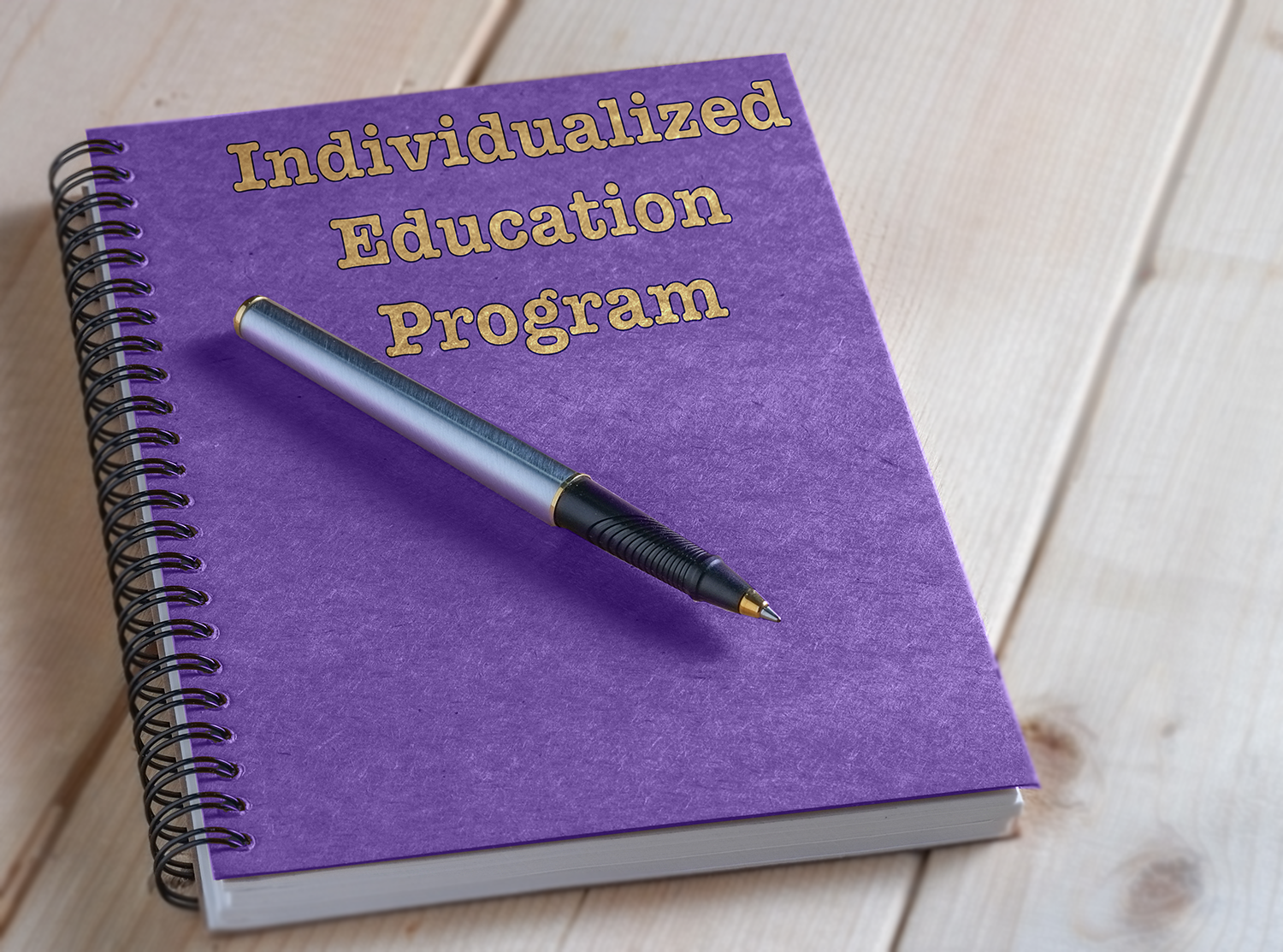What is included in the IEP document?
Page 5: The IEP Content
 Recall that the student’s IEP is the blueprint of her FAPE. It is intended to be a fluid document that lays out the special education services and supports that will be delivered to the student, based on her unique needs. As we mentioned in a previous section, IDEA stipulates that every student’s IEP must contain certain specific components in order to meet procedural requirements. Let’s revisit each of these components in more detail.
Recall that the student’s IEP is the blueprint of her FAPE. It is intended to be a fluid document that lays out the special education services and supports that will be delivered to the student, based on her unique needs. As we mentioned in a previous section, IDEA stipulates that every student’s IEP must contain certain specific components in order to meet procedural requirements. Let’s revisit each of these components in more detail.
| Component | Content |
| Present levels of academic achievement and functional performance (PLAAFP) | These statements summarize the student’s abilities in both academic and/or functional skill areas and include how the student’s disability affects her involvement in the general education curriculum.
x
functional skills glossary |
| Challenging, ambitious, and measurable goals | These goals describe what the student is expected to accomplish, in academics and/or functional skills, in a 12-month period. The goals help IEP team personnel determine whether the student is making educational gains and whether the program is providing meaningful educational benefit. |
| Description of special education and related services and supplementary services | This is a statement of all of the educational services to be provided by the school in order to help the student meet her annual goals. These services should be based on peer-reviewed research to the greatest extent possible and be provided in the LRE.
x
peer-reviewed research Research findings that have been through a standard process of review by experts in the field, who also make recommendations regarding possible revisions and whether or not the manuscript that describes the findings is worthy of publication; although this term was used in the 2004 reauthorization of IDEA, the term evidence-based practices is more current. |
| Method for measuring and reporting progress | This is a description of how the student’s progress toward the annual goals will be measured and how and when school personnel will inform parents about that progress (e.g., quarterly reports, concurrent with the timing of report cards). |
| Explanation of the extent the student will not be educated with nondisabled students in the general education setting | The “reverse phrasing” of this requirement is purposeful. IDEA requires the IEP team to justify any decision that removes the student from the general education setting. |
| Statement of student’s participation in state and district-wide assessments | This not only includes the extent to which the student will participate but also any testing accommodations or modifications that she may require. |
| The date of service initiation, frequency, duration, location | Service initiation—the date that the special education and related services identified in the IEP begins—should start as soon as possible. The frequency (e.g., number of times per week) and duration (e.g., length of time for each session) specify the amount of services to be provided to the student, clarifying the level of resource commitment. The location where the services will be provided, or placement, cannot be determined until all of the other IEP components have been determined. |
The student’s IEP must contain all seven components listed in the table above. Additionally, these components must be internally consistent because determinations in one section are based on information from another. In other words, all the parts must fit together seamlessly.
Implications of Endrew on IEP Development
Recall that the Endrew decision focused, in part, on the quality of the education, as laid out in the IEP, to which students with disabilities are entitled. This individualized education must be developed based on the student’s unique needs, or according to the Supreme Court, “reasonably calculated to enable the child to make progress appropriate in light of his circumstances.” Let’s examine two of the terms from that phrase more closely.
Reasonably calculated: The “reasonably calculated” standard recognizes that developing an appropriate IEP requires a prospective judgment by the IEP team. Generally, this means that the team will make decisions that are informed by their own expertise, the progress of the student, the student’s potential for growth, and the views of the student’s parents. In determining whether an IEP is reasonably calculated to enable a student to make progress, the IEP team should consider factors such as:
- The student’s previous rate of academic growth
- Whether the student is on track to achieve or exceed grade-level proficiency
- Any behaviors interfering with the student’s progress
- Additional information and input provided by the student’s parents
Progress appropriate in light of a child’s circumstances: Although the Supreme Court did not specifically define the phrase in light of the child’s circumstances, the decision emphasized the individualized decision-making required in the IEP process and the need to ensure that every student should have the chance to meet challenging objectives. The ruling reinforced IDEA’s focus on the individual needs of each student with a disability.
Listen as Mitchell Yell provides his insight on both of these terms.

Mitchell Yell, PhD
Fred and Francis Lester Palmetto
Chair in Teacher Education
Professor, Special Education
University of South Carolina
Reasonably calculated
(time: 1:40)
Progress appropriate in light of a child’s circumstances
(time: 2:02)
Transcript: Mitchell Yell, PhD (Reasonably calculated)
I would say reasonably calculated means a couple things. What it means, in essence, is that we as an IEP team make our best estimate based on a good and relevant and meaningful assessment of all the child’s needs. What is the child’s potential for growth? And that was a term used by the Supreme Court. What’s their potential for growth? And then we draw on our expertise as a team to make that prediction of what should be reasonable growth. That’s why they say reasonably calculated—we reason together. A couple of things are very important. Number one, the parents have to be part of that process. Another thing that’s very important is the Supreme Court has said that due process hearing officers or courts can ask, and we expect an answer when they ask, “Why did you think that would result in student progress?” So, in other words, the ‘reasonably calculated’ means we use our best estimate, given all the information that we collected in the assessment, we talked to the parents, we’ve decided what we think that child’s potential for growth is. And courts and hearing officers can later ask and expect, according to the Supreme Court, a cogent and responsive explanation to the question, “Why do you think that was reasonable progress?” So, that’s what reasonably calculated means. We just use our best guess, given the assessment, where we can expect the child to be.
Transcript: Mitchell Yell, PhD (Progress appropriate in light of a child’s circumstances)
The progress appropriate in light of a child’s circumstances… There was a real change because it used to be appropriate progress and they changed that around to progress appropriate in light of a child’s circumstances. What that means is, when we do our assessment of a child it must address all needs, be relevant and meaningful, and then we take that information and we project out what the goal should be. And these goals should be appropriate in light of those assessment results. So again, that is up to our expertise as an IEP team, working together with the parents to look at that assessment and decide, “What is the child’s potential for growth?” and then estimate or come up with our ideas of what a reasonable but ambitious goal should be, based on the assessment.
The best practices, if we consider the term in light of the child’s circumstances, are number one: to remember that the assessment is the baseline for everything that comes after it in the IEP. If we use the analogy of a house being the actual IEP, the assessment is the foundations of the house. And if the assessment is incorrect or the assessment isn’t a good foundation, the rest of the house or IEP tends to fall. So everything is based on the assessment and that’s really the keystone of everything that we do. So it means our best practices are: We do a relevant assessment of all of a child’s needs. And then we link that to the rest of the IEP. If we identify a need, we have to address it with a goal or a service, but most likely both a goal and a service. And then we have to monitor progress. But it’s all based on that original assessment.
Legislation and Litigation 
The IEP is not a form document. It is constructed only after careful consideration of the child’s present levels of achievement, disability, and potential for growth.
According to the Supreme Court, the educational benefit requirement of IDEA is satisfied and a student has received a FAPE if the student’s IEP sets out an educational program that is ‘reasonably calculated to enable the child to make progress appropriate in light of his circumstance.’
Substantive Requirements
Whereas procedural requirements stipulate when and how the IEP is developed, substantive requirements represent what is developed in the IEP. Substantive requirements involve the actual content of the individualized special education program and focus on the educational benefit conferred by a student’s IEP. The program must be aspirational, in that it maintains high expectations while enabling the student to make meaningful progress, given the student’s unique needs.
With an understanding of the different components of the IEP and how they fit together to form a cohesive program, the IEP team now can begin to develop an educationally meaningful IEP. The next pages of the module address the ways in which the substantive requirements of IDEA can be met to develop a high-quality IEP. More specifically, the pages explain how to determine:
- Present levels of academic achievement and functional performance statements
- Challenging, ambitious, and measurable goals
- Special education and related services
- How the student’s progress will be monitored and reported
- Common substantive errors and how to avoid them